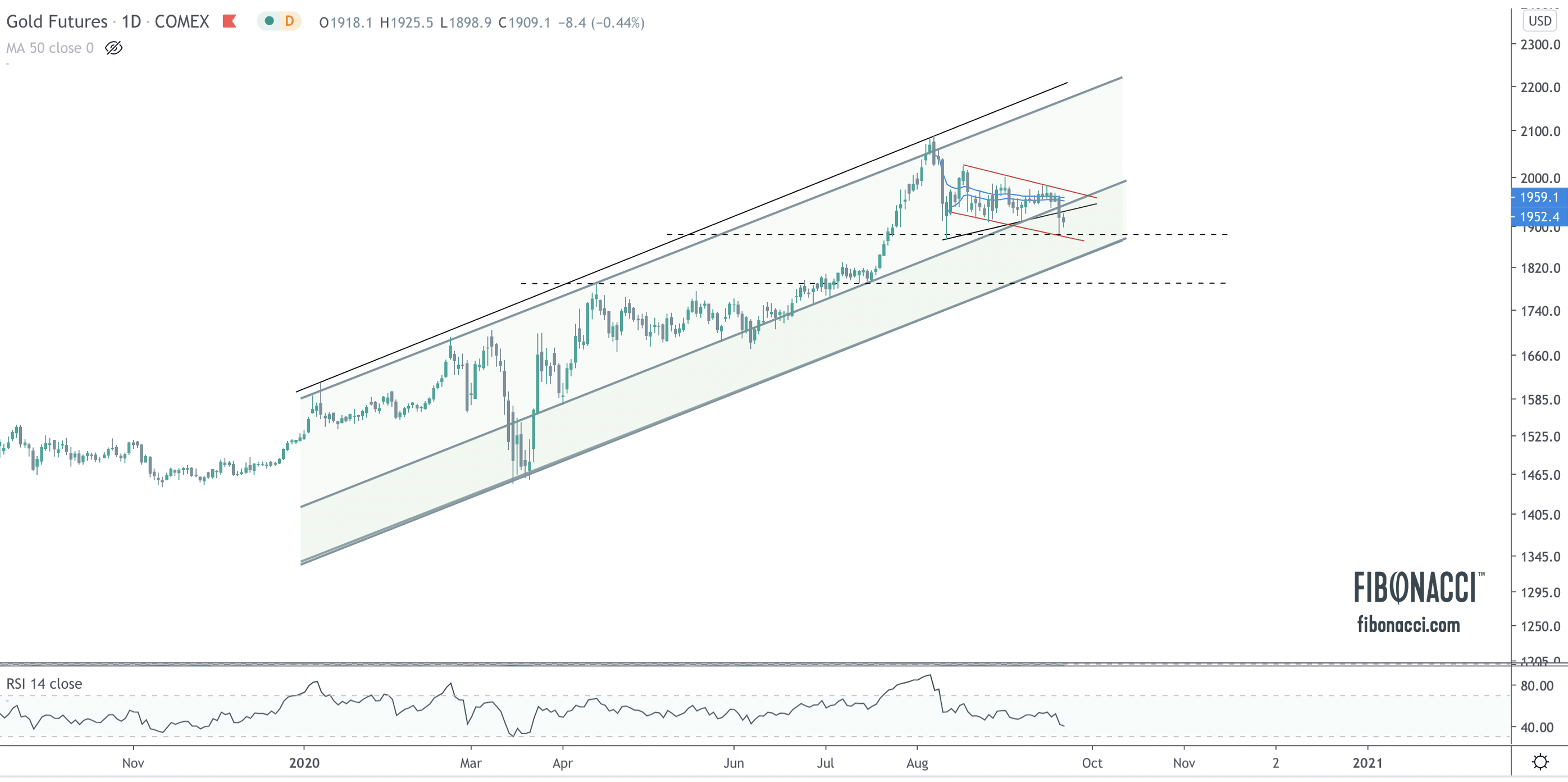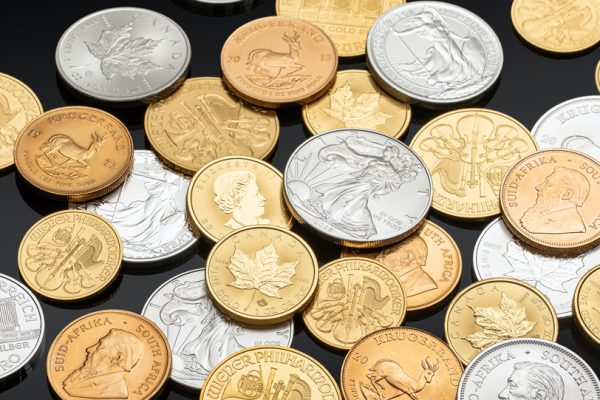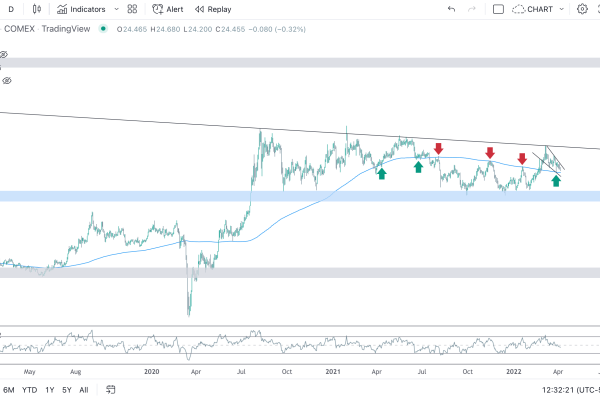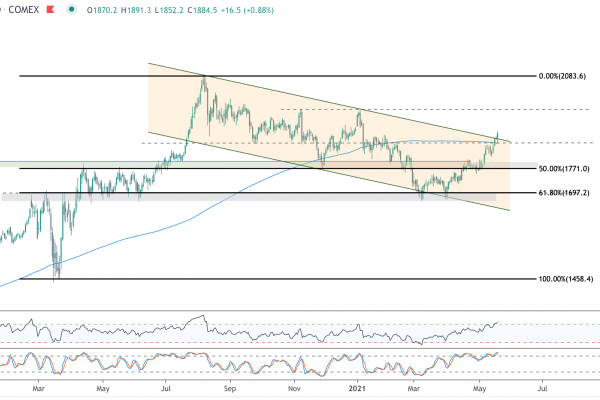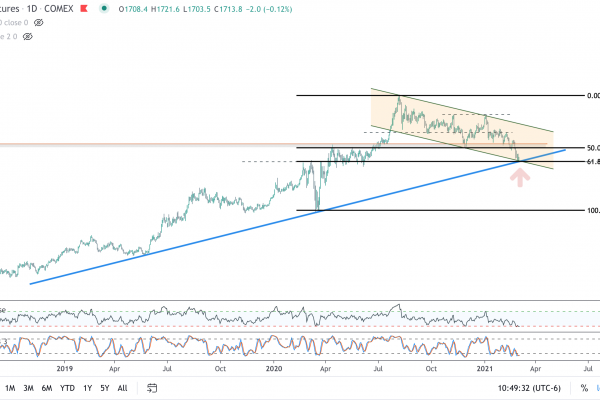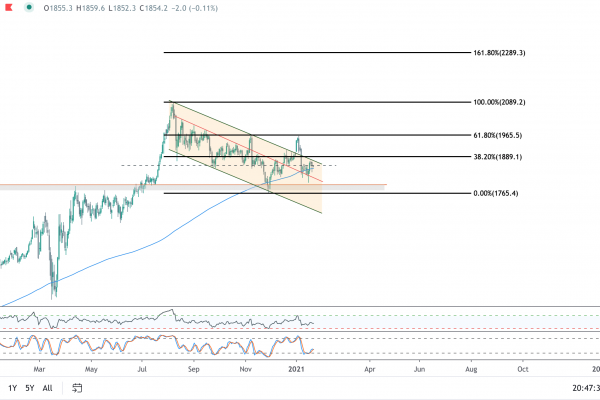Buying silver and gold each have their own set of advantages and disadvantages. Let’s explore them:
Advantages of Buying Silver:
- Lower Price Entry: Silver is generally more affordable than gold, making it accessible to a wider range of investors. This lower price point allows individuals with smaller budgets to invest in precious metals.
- Industrial Demand: Silver has various industrial applications, including electronics, solar panels, and medical devices. This industrial demand can potentially support the price of silver, especially during economic expansions.
- Higher Volatility: Silver tends to exhibit higher price volatility compared to gold. For active traders and investors who are looking for short-term opportunities, silver’s price swings can provide more trading opportunities.
Disadvantages of Buying Silver:
- Price Volatility: While higher volatility can be an advantage for traders, it can also pose significant risks for long-term investors. Silver’s price swings can lead to larger losses during market downturns.
- Less Value Retention: While silver can act as a store of value, it may not preserve wealth as effectively as gold over long periods. Gold’s rarity and historical significance have given it a stronger reputation as a wealth-preserving asset.
- Market Liquidity: The silver market is smaller and less liquid than the gold market. This can result in wider bid-ask spreads and potentially make it more challenging to buy or sell large quantities of silver without impacting its price.
Advantages of Buying Gold:
- Store of Value: Gold has a long history as a store of value and a hedge against inflation and economic uncertainties. Its scarcity and inherent value have contributed to its reputation as a wealth-preserving asset.
- Portfolio Diversification: Gold’s low correlation with other financial assets makes it an effective diversification tool. During times of market turbulence, gold often behaves differently than stocks and bonds, helping to reduce overall portfolio risk.
- Global Acceptance: Gold is recognized and accepted as a form of payment worldwide. It can be easily converted into cash or used for trade in various countries, providing liquidity and flexibility to investors.
Disadvantages of Buying Gold:
- Higher Price Entry: Gold is more expensive than silver, making it less accessible to some investors with limited budgets.
- Storage and Security: Physical gold requires secure storage, which can incur additional costs and present security concerns. Investing in gold through exchange-traded funds (ETFs) or other financial products can mitigate this issue but may not provide the same tangible ownership benefits.
- Slower Price Movements: Gold typically exhibits slower price movements compared to silver. While this can be an advantage for stability, it may not be as attractive for short-term traders seeking rapid price fluctuations.
Should I Buy Gold or Silver?
Ultimately, the decision to invest in silver, gold, or both depends on an individual’s financial goals, risk tolerance, and investment strategy. Some investors may choose to hold a combination of both metals in their portfolio to benefit from their distinct advantages. As with any investment decision, it’s crucial to conduct thorough research and seek advice from financial professionals when necessary.
Silver remains a slow moving, frustrating long position for metals bulls who have remained steadfast over the past two years while watching base metals, energy, ags, and virtually all other commodities explode in price over the past 18 months. Since the price peak in August of 2020, Silver is down almost 20% while the DBC commodity tracking ETF is up 170%. Let’s take a look at the tape.
Silver has been flirting will long term support at 21.80 (tested 6 times since the breakout in 2020), and falling resistance from the 2011 high (which it has also tested six times). Within this long, two year price consolidation between long term support and long term resistance, action can be further broken down into response and activity around the 200 day moving average, where price found support in the spring and summer of 2021, broke in July and retested (and rejected) three times throughout the winter until finally breaking through in February. Last week’s sell-off pushed price right to the 200 DMA, where it found support and bounced hard.
Price is now forming a bull wedge, and a breakout of the wedge would likely precipitate a run to falling resistance in the $27 zone. With RSI sitting in the 40s, there is some potential energy in the system for a near term move.

Zooming out, silver looks good structurally. Price consolidation at long term support at 21.80 is clearly visible and forming a two-year ascending triangle. Big picture, the measured move on a breakout above $30 would create a price target right at $49 (at or around prior all-time highs). I view $30 as a key level, because it was the prior high in January 2021. A clean break above that level becomes very bullish.
Conversely, a breakdown below support at 21.80 would be bearish and likely precipitate a price waterfall back into the low teens.

As always, we appreciate your feedback!
Gold
It has been awhile since I posted an update on metals, largely because metals have been stuck in quiet consolidation mode until the past week or so. We have been watching falling trend channel resistance on gold for the past six months, and after the double bottom in March around the 61.8% Fibonacci retracement, gold has steadily climbed, recapturing the 200 day moving average for the first time since February 2nd and breaking out above falling resistance of the multi-month bull flag that commenced with the August ’20 peak. Price action looks exceedingly constructive here, with RSI now in overbought territory for the first time in nine months. Bulls want to see price hold the 200 DMA, or at least stay above 1840. There is blue sky to 1965 if it does.
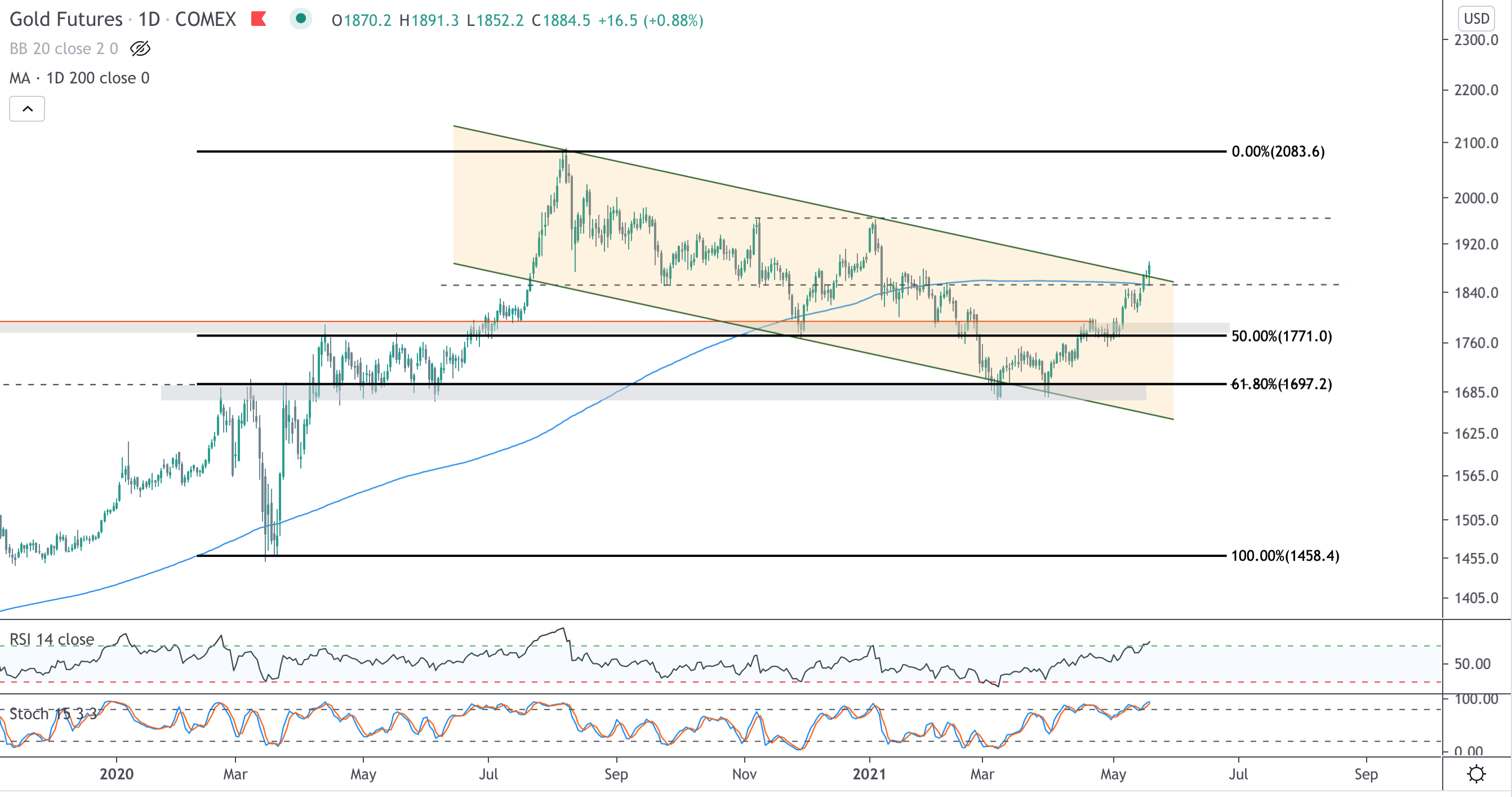
Silver
Gold has been the laggard. Higher beta silver, as well as mining stocks, have led the way. Silver broke the 200 DMA in early April, and has once again hurdled the troublesome 25-27 area. Bulls need silver to hold 28.50 for a retest of 30, which it struck twice in the last nine months. A break of 30 should precipitate a swift move to the 161.8 Fibonacci extension at 35, which coincides with the October 2012 peak.
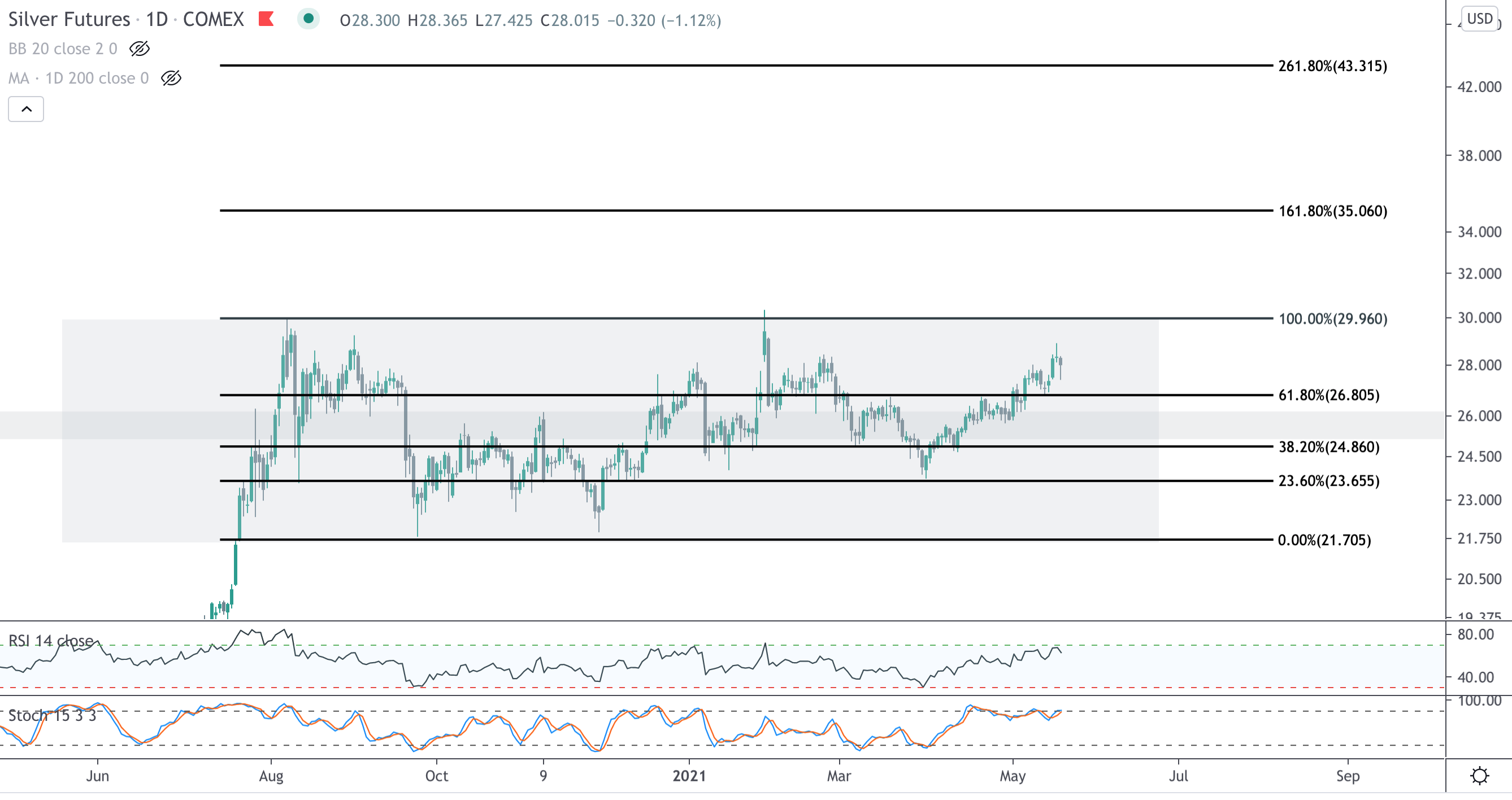
Gold Miners
GDX, the Gold Miner ETF, broker falling resistance on the 4th test back on April 15th, successfully retested, and has pushed its way back to the 61.8 Fibonacci retracement from the August high. Constructively, price has never fallen into oversold territory from the entire move following the March 2020 low – even during this long consolidation period. We are likely to see some digestion of price at these levels, but a break of 40 should ignite a move to retest the August 2020 high at 45.85.
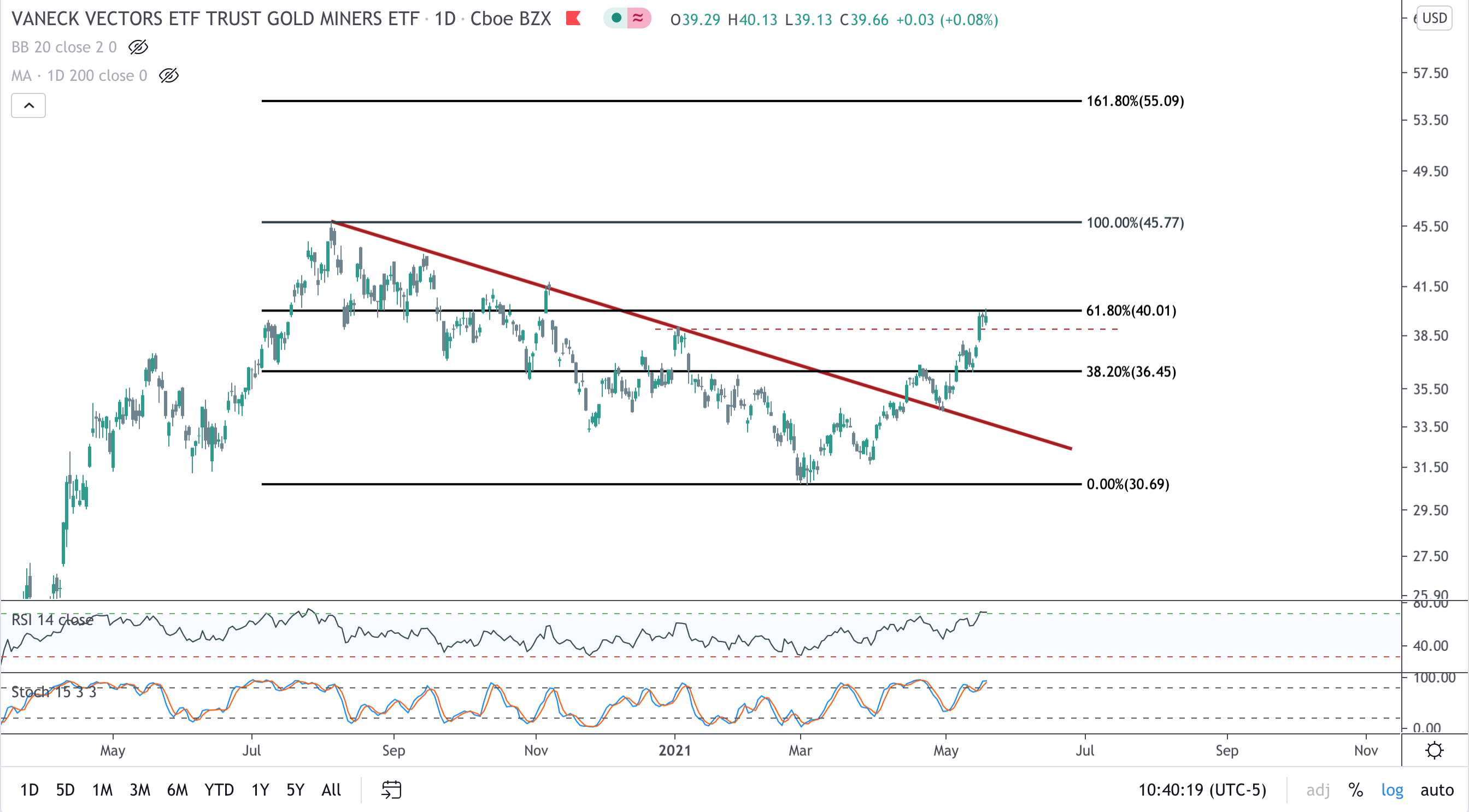
As always, we appreciate your feedback!
Gold
For the past month gold has been trading in a range between 1720 and 1780, struggling to make the breakout leap it seemed to promise the first week of the year. Gnawing at bulls is the fact that every other commodity, like copper, gold, zinc, and others, have exploded higher while gold seems stuck on the launch pad.
It seems to me that gold is leading, not lagging the other commodities. Gold’s move in 2020 preceded, and even foreshadowed, the run in base metals and other commodities. Since then, the market has digested those gains while rotating capital into other assets.
This is depicted in the chart via a multi-month bull flag, which is a depiction of sellers taking gains against waning appetite on the demand side. This is healthy, and gold, thus far, remains in an uptrend.
The chart below now has gold coming into multiple support areas: rising trend support from the March 2020 low, falling channel support from the 2020 high, the 61.8% Fib retracement from March trough to September peak, and horizontal support.
Furthermore, sentiment is now at its worst since late 2015 as investors find returns in nearly every other asset class. The situation seems ripe for a rally, and at the very least, risk/reward seems to favor the bulls.
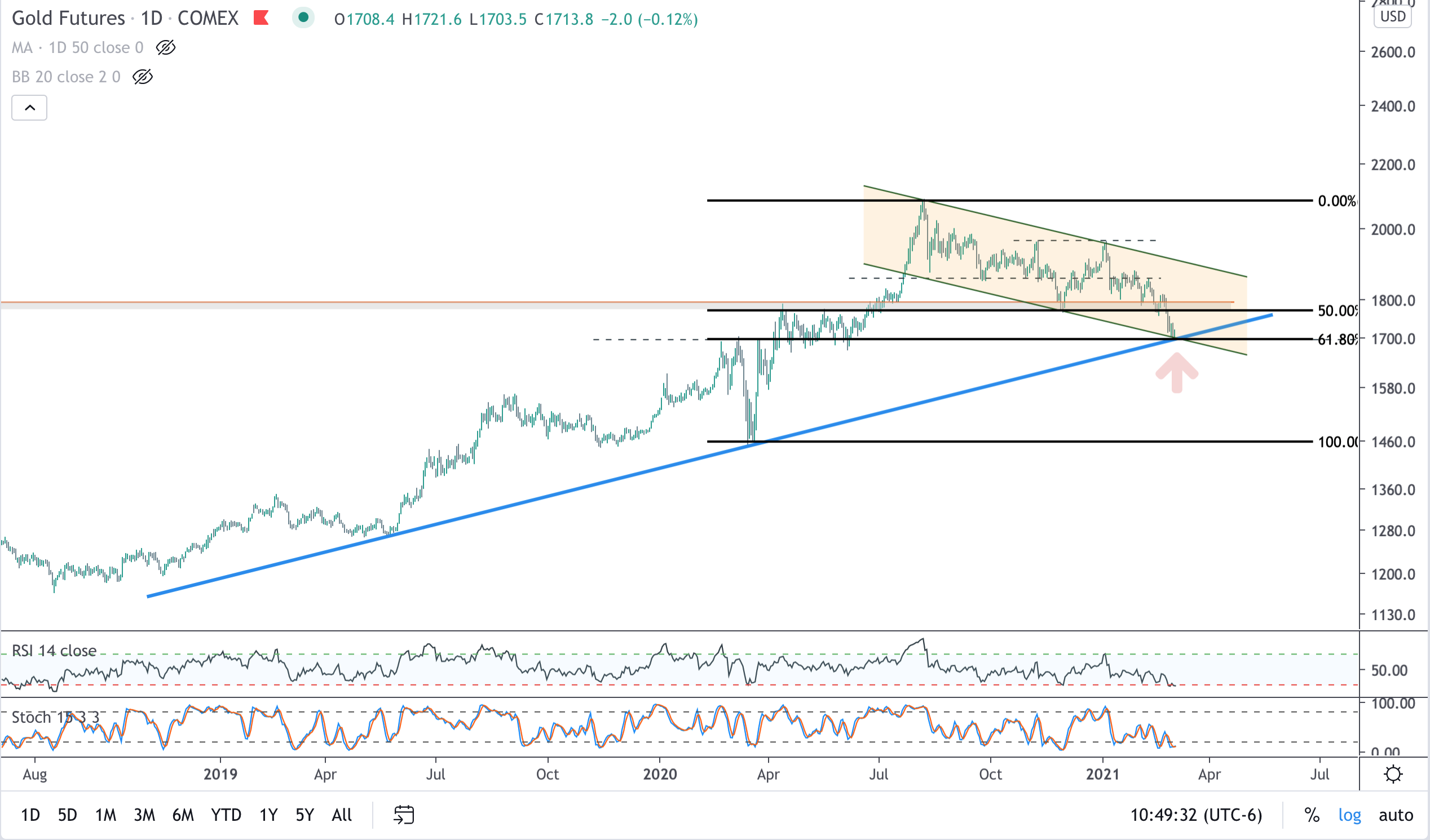
GDXJ – the gold junior mining ETF – is similarly coming into channel support and horizontal support, and price has not been oversold throughout the entire consolidation period. If gold and the gold miners are to rally, this is the area to do so.
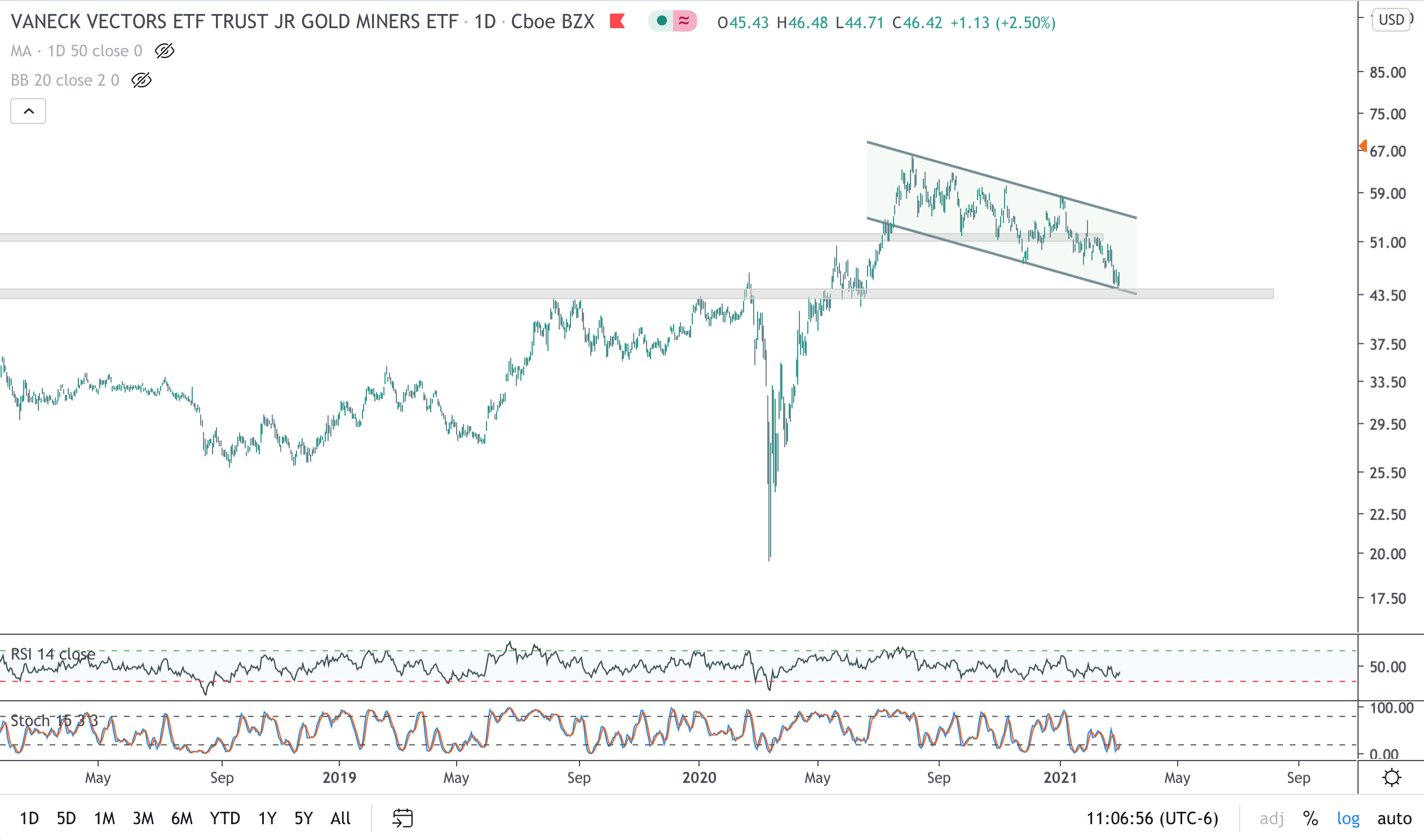
As always, we appreciate your feedback!
Gold
Metals bulls have been frustrated with repeated attempts to break out of a multi-month bull flag/falling channel. At the turn of the new year, with the presidential election all but behind the country, and with calls for more money-printing and ongoing stimulus, it seemed a given that – like the base metals and energy – gold would break out and follow the inflation narrative to higher prices. And, for three days, that is just what happened, as gold pushed from a 2020 close of $1895 to $1960 in the first three days of the new year, only to sell off hard and fall back below falling trend line support. This was gold’s second pass at $1960, which was the 6.18% Fibonacci retracement from the August high to the November low. As the saying goes, from failed moves come fast moves, and the failed move precipitated a $160 sell-off in a week and a half ($140 of which occurred in the 3 days following the peak). It was a major head fake for bulls and stopped out many traders who bought the breakout. Price also lost the 200-day moving average, which was another warning sign for bulls.
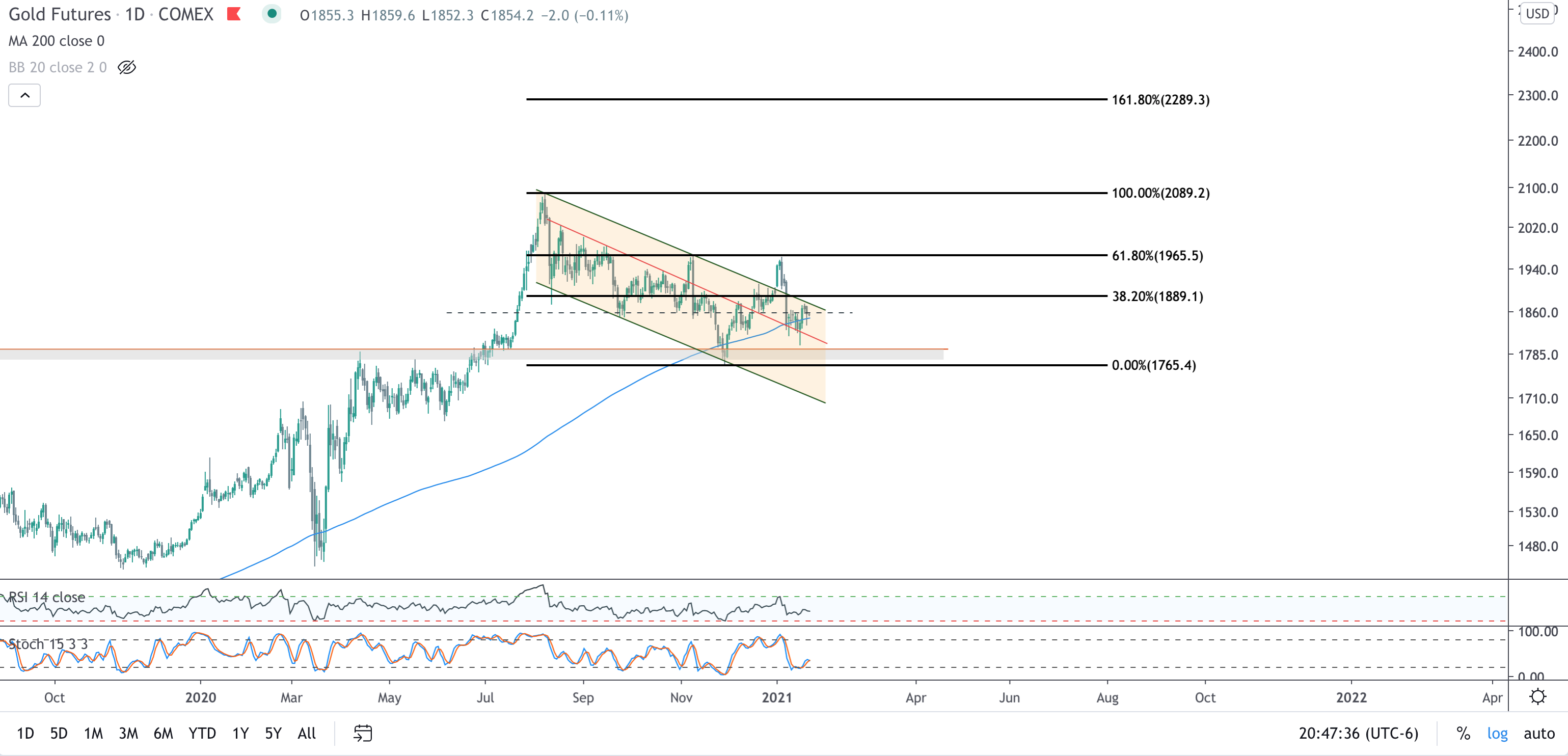
On the positive side, price recently recovered the 200-day moving average, stochastics have turned up, and despite the rapid selloff earlier in the month, the daily RSI never hit oversold conditions. Instead price has been stuck in no man’s land between 1800-1900 per ounce. The next real move can’t begin until gold recovers $1890 to break falling resistance and hurdle the 38.2% Fib retracement.
Silver & Platinum
While gold has struggled, silver and platinum have remained surprisingly resilient. The higher beta cousins of the yellow metal tend to trend with gold, but more dramatically in percentage terms. It would seems both are being supported by the run-up in base metals, as each have industrial properties that are far broader than gold. In fact, on several occasions this month silver and platinum have traded up on days when gold has traded down. Silver remains stuck at long term support between $25-$26, nearly broke rising trend support with intraday dips into the $24 range, only to close above support. It’s now decision time as price is pinching between horizontal resistance and rising support. A key pivot point is $26.07, and a secular breakout occurs above $28.11.

For platinum, $1200 is the key level to watch. As platinum approaches $1200, I would expect to see some consolidation or a pullback as it builds the necessary power to break through long term resistance. This has been the key level since 2014. A break above $1200 opens up a move to $1300, above which would be extremely bullish.

Dollar
The recent dollar rebound has been the major headwind for the metals. As I stated in a previous post, the trend remains down and all signs point to further weakness. One final thrust towards 91 seems plausible, but ultimately price seems destined for 88.

S&P 500
The inflation narrative and weakness in bonds have supported higher equity prices. The Nasdaq in particular is an unstoppable train. Equity markets across the globe have been breaking out, and risk appetite is growing. Whatever you may think about valuations and the weakness of underlying economic conditions, all signs point toward higher equity prices ahead. For the S&P 500, 4000 is an important psychological level, with my near term target pushing to 4150.

As always, we appreciate your feedback!
The month of November was a bit of a roller coaster for metals bulls, as price appeared to breakout, only to reverse on vaccine news and become extremely oversold by mid-December. All the more frustrating was the continued sell-off in the US dollar, which many expected to spark the next leg higher in metals prices, but new lows in the dollar coincided with multi-month bottoms in metals. Meanwhile, all attention has since returned to bitcoin, which broke out to all-time highs while metals remained in consolidation mode. So, where are we now?
The thesis that I outlined in my post on October 14th remains the same: Metals up, Equities Up, Dollar down. The expectation then, as now, is for the 2021 reflation/inflation trade. To be clear, this expectation is not based on any personal macro-opinion; it is based on how I see price reacting to this general market consensus. The market can be wrong, and if it is, and inflation expectations are overblown, the price will warn us.
Let’s start with the hot topic du jour: Bitcoin.
Bitcoin
Bitcoin finally eclipsed its 2017 euphoric high last week and screamed to just north of $24,000/coin, which represents the 127.2 Fib Extension measured from the 2017 high to the March 2020 low. Fundamentals aside (are there any?) price looks poised to test $30,000 (the 161.8 Fib extension) on the next thrust. By any technical measure, bitcoin is in a major secular bull market, and the heights it may reach will likely shock many.

Silver
Silver broke out in a big way in overnight trading with a massive $1.40 move late Sunday, December 20th. After finally breaking through falling resistance of its bull wedge in early December, silver eclipsed the all-important $26 level, which has served as either support or resistance no less than 11 times since 2011, and most recently following the September blow off high. This breakthrough now sets up an initial retest of $30/ounce, with $37 beyond there.

Long term:

Gold
Gold has quietly rallied $140 since the big sell-off in late November, and it is now knocking on falling resistance of its multi-month bull flag. As of this writing, price is on the cusp of a breakout at $1910, which sets up a quick retest of $1940 and $1960, above which should push price back north of $2100.

GSR
The Gold:Silver Ratio also continues to trend lower, which is an encouraging sign for bulls, as it implies stronger risk appetite in the space.

US Dollar
For the US Dollar, there is not much to add here. The trend is down, and 88 is a very key level, where we should expect to see some near term support. If price doesn’t hold there, the US dollar will likely fall into the 70s on the index.

As always, we appreciate your feedback. Have a Merry Christmas!
In my last post, I commented on the strong breakouts in metals out of bull wedge consolidations. These breakouts were ultimately short-lived and quickly reversed on vaccine news, washing out swing longs and once again pushing price lower to another test of falling resistance. The thesis from that post remains intact – metals continue to remain in strong uptrends with price likely to push to higher highs – but in the near term price continues to digest supply and needs more time.
GOLD
Gold has a confluence of support coming in at 1832, 1828, and 1822. Below there, 1790 lingers as the key breakout level from the 7-year base. With stochastics oversold, the downside on this selloff looks limited. For those with a longer time horizon, the area between 1790-1830 is a strong area of support.

SILVER
In Silver, I am watching 23.08 (retest of 161.8 Fibonacci extension) and 22.57 (the anchored VWAP from March low) as important levels. Like gold, silver is getting a little oversold on stochastics and I think the 22.57-23.08 is very likely to hold.

10-Yr NOTES
Gold has been highly correlated to 10-year notes, which have also been consolidating and are now coming into rising support from the October 2018 low. Long consolidations like this within strong uptrends are much more likely to resolve in the direction of the underlying trend, and if 10-year notes rally off support, we can expect gold to be not far behind.

As always, I would love to hear your feedback. And Happy Fibonacci Day: 11-23!
Today is November 6th, we still do not have a President-elect, and the legal fight over ballots and vote-counting seems destined to drag on for weeks, if not months. For those investors determined to allocate capital based upon the election outcome, the uncertainty can be paralyzing. We can expect a likelihood of a split government, but there is no certainty beyond that. My solution is to follow price.
In my last piece, I noted that precious metals were trending up, and the US Dollar was trending down. Yesterday’s price action confirmed that, following a multi-week consolidation period, these trends have resumed.
Big Gold Breakout
Using the March peak/trough in gold has been a reliable Fibonacci measure for extension levels. The pullback from the August high was nothing more than a rejection at the 261.8 Fibonacci extension and a retest of the breakout at the 161.8 extension. Yesterday’s bull wedge breakout on a monster $50 candle, while breaking out above the 50 day moving average, suggests that gold is setting up for another run to 261.8 extension. Note also that after getting extremely overbought at the August peak, gold never hit oversold conditions throughout the entire consolidation period, suggesting that bulls are still in control.

Silver Also Confirming
Silver made a statement with yesterday’s bullish move. I noted on election night that silver looked vulnerable and needed to breakout in order to avoid future trouble. Within 48 hours price exploded out of its bull wedge on a $1.60 single day move. The chart looks extremely constructive now. The anchored volume-weighted average price from the March low held throughout the consolidation period, and similar to gold, 161.8 Fibonacci extension from the March low held, the bull wedge broke to the upside, the 50 DMA was eclipsed, and price is now retesting prior support at $26. A move above $26 should push a retest of the 261.8 Fibonacci extension.

Gold/Silver Ratio – false breakout
Earlier this week, the Gold/Silver ratio appeared to be breaking out, which was concerning for bulls. Generally, a rising GSR is a risk-off signal for metals (gold outperforming silver). The big turnaround in yesterday’s price brought the ratio back below falling resistance. As the saying goes – “from failed moves come fast moves.” A weekly close below falling resistance increases the likelihood that the ratio will continue to fall.

GDX and GDXJ Breaking Out Also
The charts of GDX (Gold Miners ETF) and GDXJ (Gold Junior Miners ETF) look very similar. The chart below is that of GDXJ. After breaking out above long term resistance at $52, price has neatly consolidated for three months forming a multi-month bull flag which perfectly retested prior resistance (now support). Yesterday, price finally broke falling resistance of the bull flag. Like gold and silver, these junior miners never hit oversold conditions through the consolidation and appear poised for the next leg higher.

Equities also look constructive
The S&P 500 is up also 300 points from the election night low. The key 3230 level – which has acted as both resistance and support and has been tested four times since May – held. Price is now coming into falling resistance from the August high. 3530 is resistance to the upside. Bulls would like to see a big push through that level to confirm the next leg higher is underway, a run that should take price to ~4,000, which is the measured move from the June breakout and the upper bound of the 12-year rising channel. Like the metals, price never hit oversold conditions on the retest of support and bulls remain in control. On the downside, 3230 remains key support, with the 200 DMA and anchored VWAP from the March low sitting just below ~3115.

The Dollar shows little sign of strength
From a technical perspective, the trend in the dollar is down. This is a fact, not opinion. The dollar has a downward sloping 200 DMA, hit oversold conditions twice during the summer, never was overbought on the short term rally, and remains on the precipice of breaking support again at 92. This is not a chart anyone should be looking to buy. A break above 95 would change the technical outlook.

As always, I would love to hear your feedback!
How Much is Produced Globally
Gold and silver have played an important role throughout money’s history. Unlike modern currencies, precious metals can’t be created out of thin air and derive value from their scarcity.
Globally, how does the value of minted gold and silver coins compare to currency creation?
On the topic of future inflationary or deflationary expectations, there are strong fundamental arguments on both sides. In my simple interpretation, the deflationary camp (dollar bulls) make the case that the economy remains fractured, entire industries are being undermined by the pandemic, there is high unemployment, the personal savings rate is up, the stock market is at stretched valuations, the housing market is approaching bubble territory, and the demand for US dollars remains the prevailing undercurrent of international trade. The Fed, despite its best efforts, cannot seem to meet its inflation target. Further economic weakness or perhaps a market crash would incite a flight to liquidity, demand for dollars to meet debt obligations, and broad debt defaults, further tightening the monetary supply. A strong dollar generally weighs heavily on the price of precious metals, particularly in short-term liquidity crises, and creates the potential for a near term headwind on metals prices.
The inflationary camp argues that the Fed – and policymakers – have shown their willingness to do “whatever it takes” to prop up the markets and inject unfathomable amounts of liquidity into the system. There is seemingly no limit to the tools available for this purpose, as we have seen direct stimulus injections into personal bank accounts, Federal programs such as PPP, and other fiscal interventions. In theory, a $1,200 stimulus check could be a $12,000 stimulus check or a $120,000 stimulus check. The government can continue to print, and can even choose to monetize the national debt.
As a technical analyst, these theories are beyond my capability to fully comprehend in whole or predict with any accuracy. I simply look at the charts to determine primary, secondary, and tertiary trends, and what those trends communicate about the environment now. My job is to react to what the market. On that point alone, this is what I see.
The dollar is trending down

The primary, multi-decade trend in the dollar remains down. From 2008-2017 the dollar produced a powerful countertrend move that culminated in its third multi-decade lower high. This countertrend move broke down in March, has since pulled back to retest the breakdown, and appears poised for another leg down. The topping pattern formed from 2015-2020 appears to be a diamond reversal pattern. The primary downtrend would be violated only if price moved above falling resistance represented as the upper bound of the falling channel. So, in brief, the long term trend is down, the bullish, decade-long countertrend appears to be over, and it would appear that further weakness is ahead.
Gold is trending up

Conversely, gold is trending up. The countertrend bullish move in the dollar coincided with a countertrend bearish move in gold, which created a 7-year base (continuation pattern) that broke out to all-time highs this year. Gold remains in a 20 year uptrend, and the breakout to new all-time highs suggests that the primary trend is resuming its upward thrust.
The stock market is trending up

The S&P500 also remains up. While a crash may be in the offing at some point in the future, the 12-year trend remains up, and even the historic Covid selloff in March was notably just a back test of the two-year price shelf from 2015-2017.
The S&P500 priced in gold is trending down

Gold outperformance relative to equities remains noteworthy. The primary, 20+ year trend remains down. During the period from 2011-2018 when gold was basing, the S&P500 outperformed gold, but this entire moved appears to be a countertrend 38.2% Fibonacci retracement, which broke down in 2019 and now appears to be resuming the downward trajectory of the primary trend. This trend suggest further gold outperformance even if the nominal price of each rises in tandem with a weakening dollar.

The same chart with only the 50 week moving average and 200-week moving average shows only three crosses over the past 20 years. These crosses are infrequent, and the 50 week MA falling through the 200-week MA in March would seem to confirm the expectation of further downside pressure in this ratio.
As always, I would love to know your feedback.
GOLD
The price coiling I highlighted in gold in my last post failed to the downside, which I mentioned was a possibility. There were two key levels, the 1865-1880 band, and then 1800, which would have retested the entire move. Buyers came in strong at 1865 and price held, right at the 100 day moving average. The breakdown from the pennant has created a bull wedge, and the RSI (relative strength index) never hit oversold levels, which implies to me that bulls remain in control. Gold is not completely out of the woods – a breakout of that bull wedge would confirm that 1865 was the interim low. I am looking for confirmation above 1935 and then 1950 for next sizable move. The price action in silver and the miners confirm this thesis.
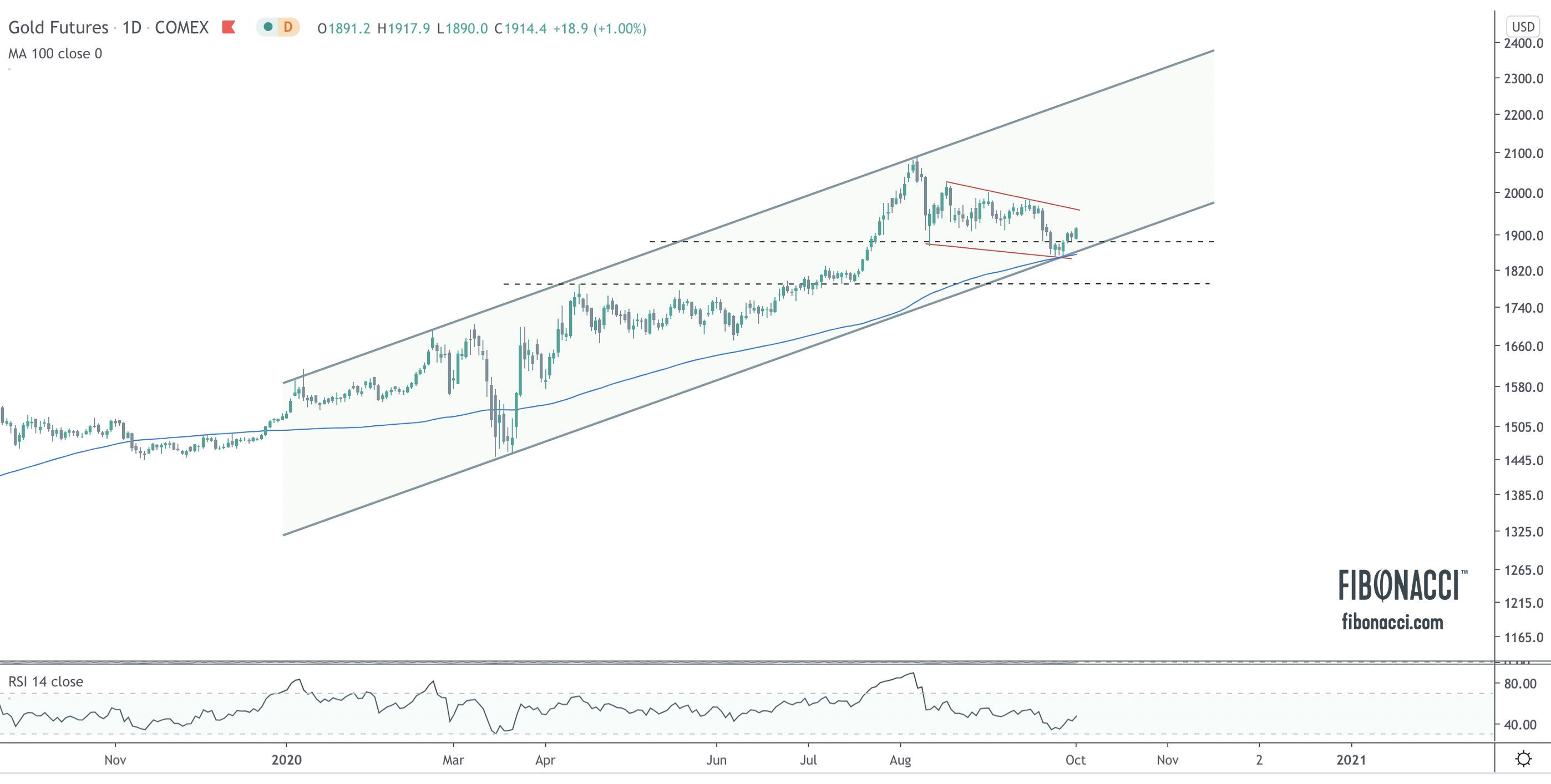
SILVER
Like gold, silver never got oversold on the 14-day RSI during the recent selloff, and price similarly bottom-ticked the 100 DMA. A break above the recent high of 24.57 should set up a retest of 26.
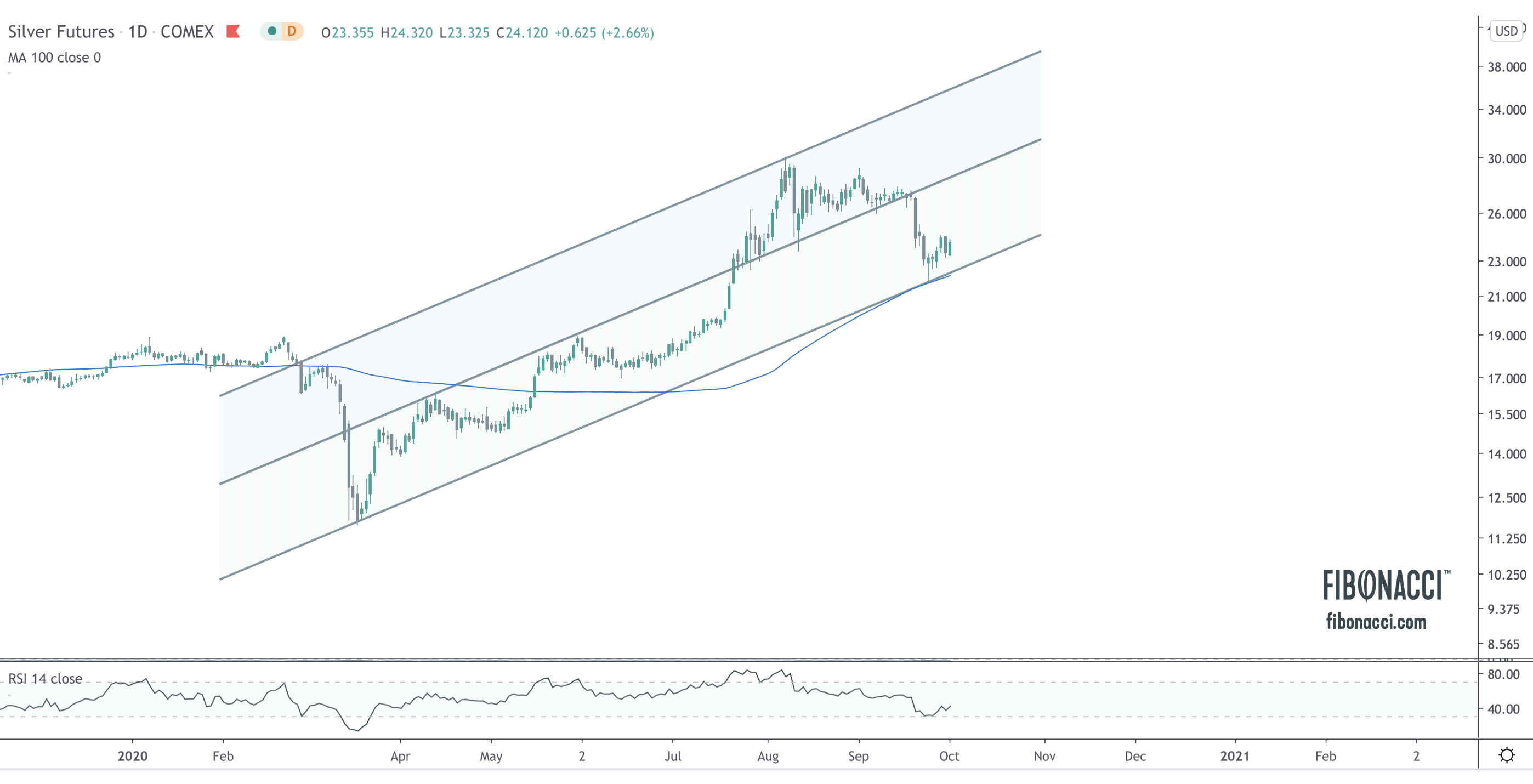
GDX – Gold Miners ETF
GDX appears to have successfully recovered support at 39. At the moment, the recent sell off looks like a false breakdown from horizontal support, and price has formed a bull flag during this recent consolidation. Like the metals, RSI never got oversold during the sell off. This looks to me like a 2-3 month healthy consolidation in order to digest the explosive gains from the March low. Bulls just need price to stay above 37.
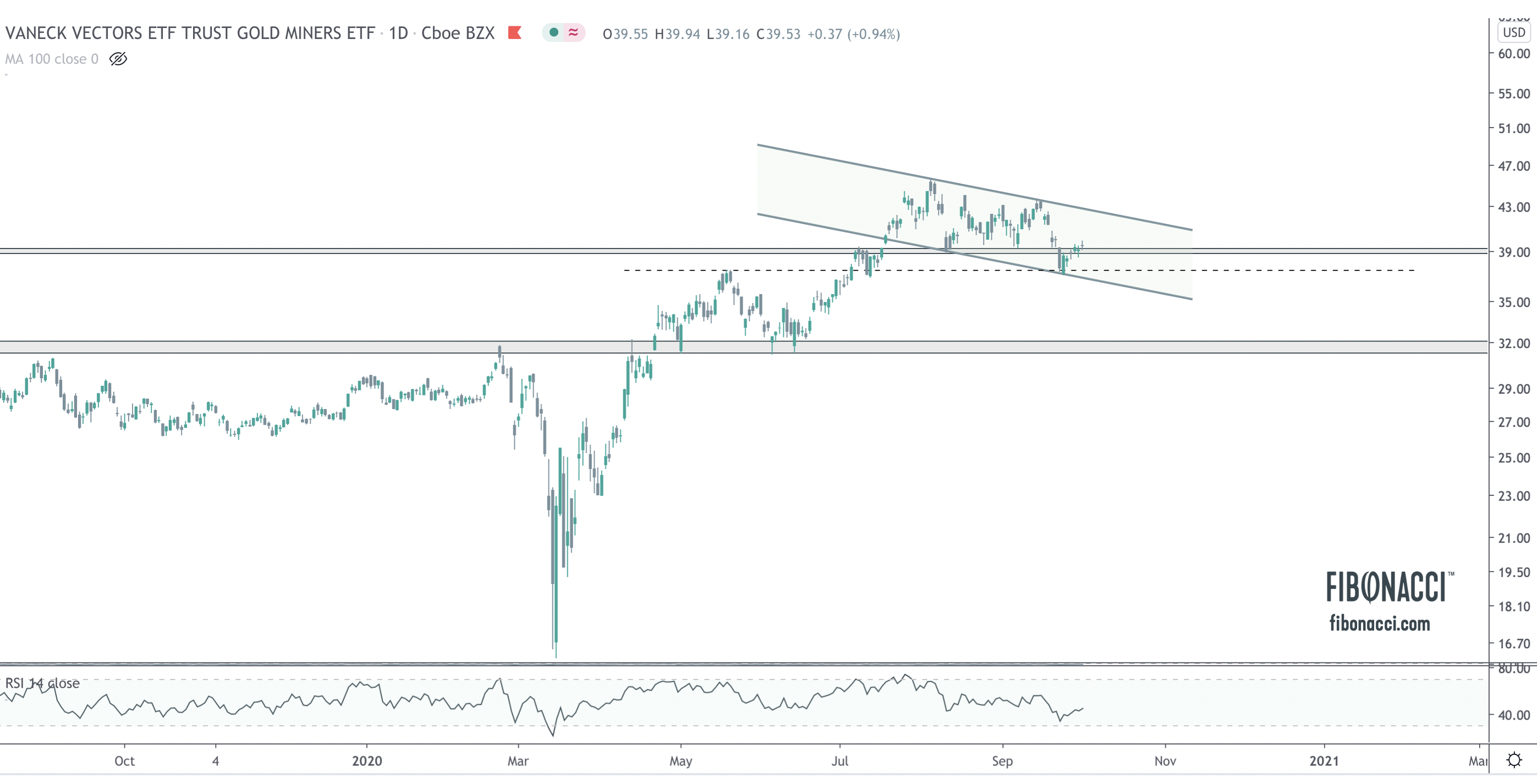
GDXJ – Junior Gold Miners ETF
The junior gold miners look even better than the majors. The entire selloff has been a simple retest of the breakout from the 2016 high. Like GDX, price has just been consolidating for 2-3 months and has formed a bull flag into support. RSI never got oversold during the selloff. Bulls want price to stay above 52.
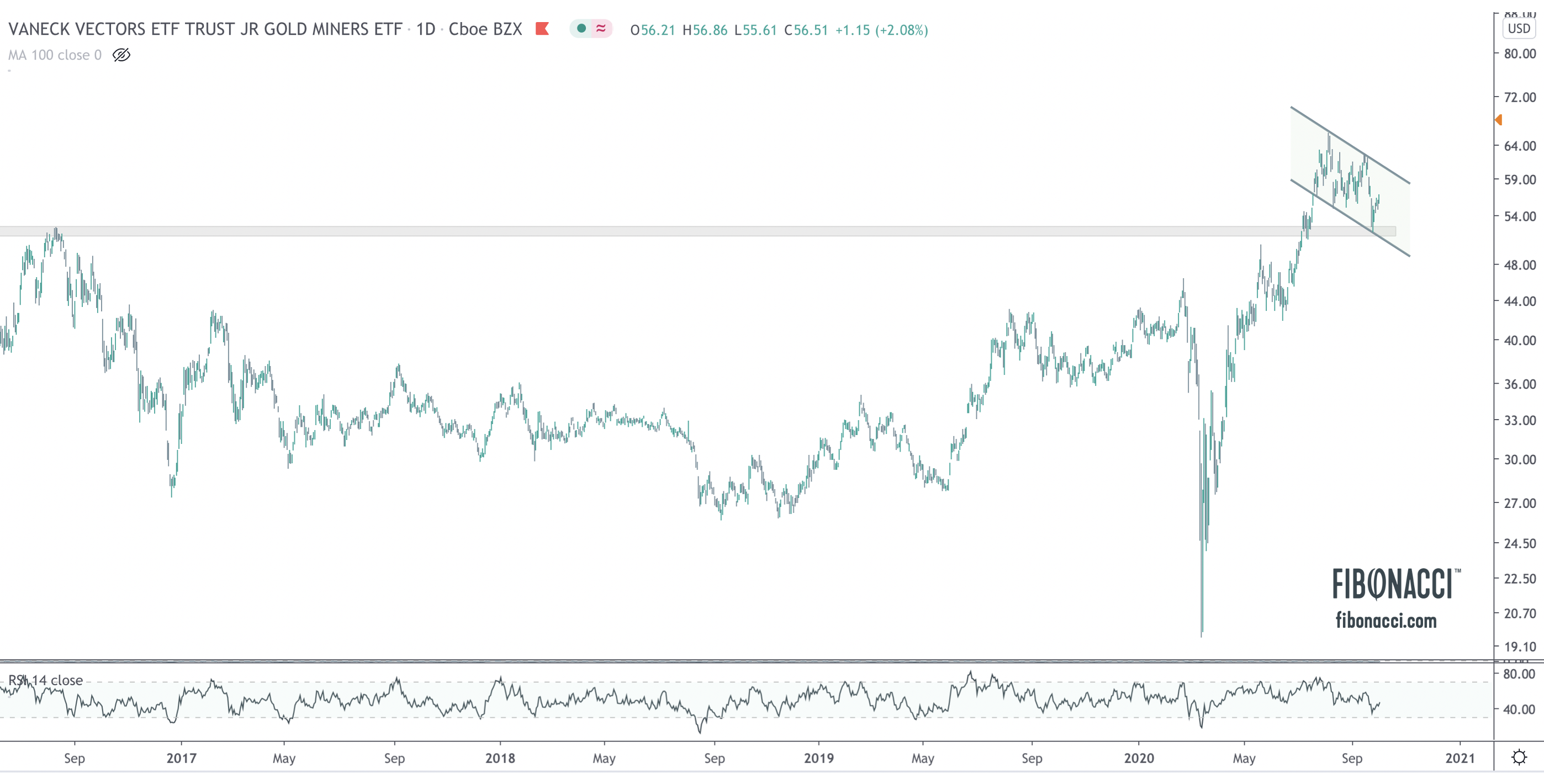
GOLD/SILVER RATIO
In a bull market, we want to see silver outperforming gold on a relative basis, which implies a lower ratio. In the chart below, we can see that the trend remains down, and the ratio is pushing up against falling resistance. A breakout in price should send the ratio falling back towards a retest of the 68 level. In this case, we notice that the RSI was “oversold”, meaning the downward fall became extreme, and the pullback never hit overbought levels, which implies that the downwards pressure is prevailing. These signs indicate silver outperformance, which is far more prevalent when prices are rising than when they are falling. A breakout of this ratio would imply a skew towards risk off, which would be less bullish generally.
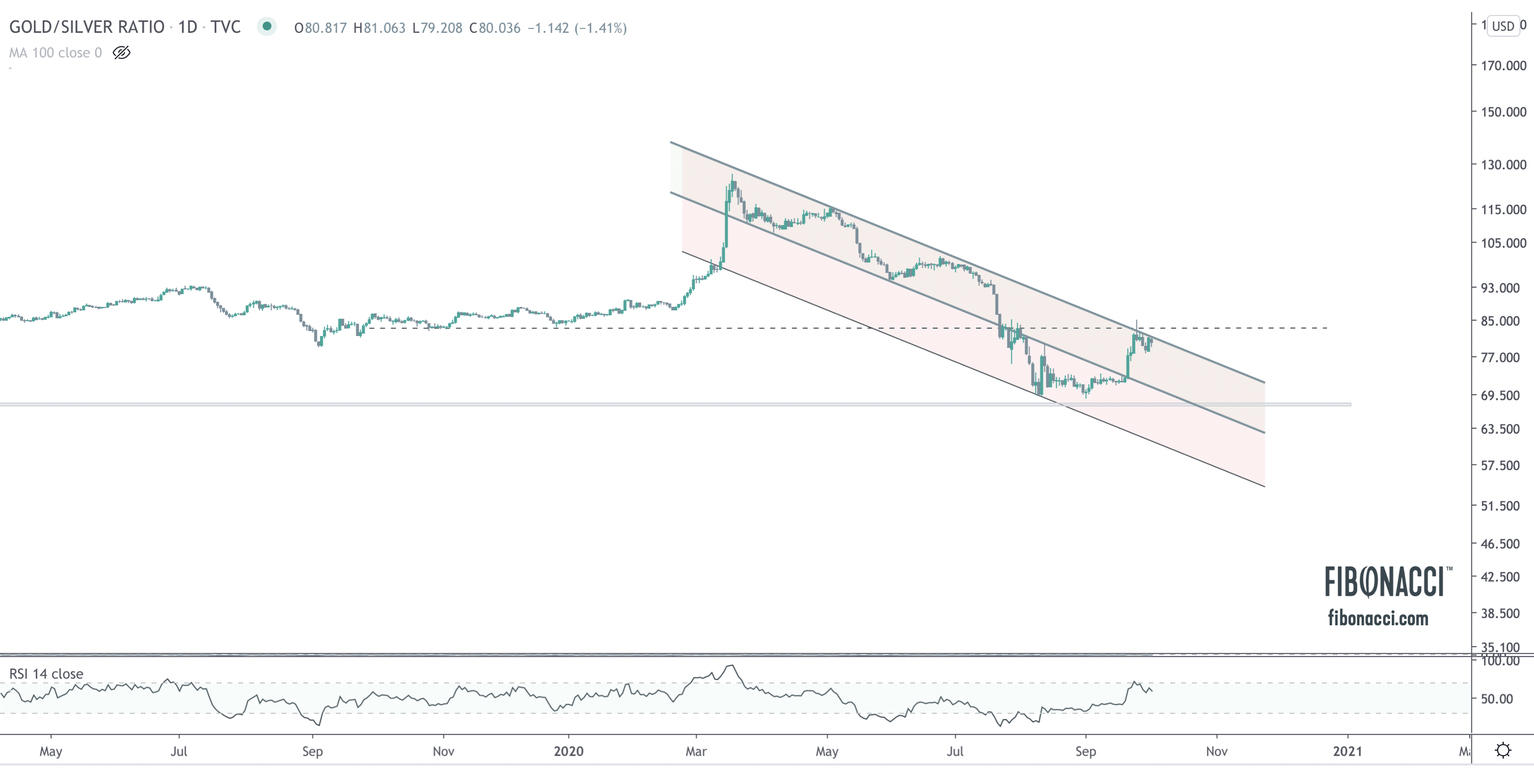
As always, we would love to hear your feedback.
GOLD
This is an update from my post on Friday:
Gold broke down from its pennant yesterday and hit first support at $1880. Price remains in a bull flag, but a break below $1875 should see a quick drop to $1800, which would be a backtest of the entire breakout.
